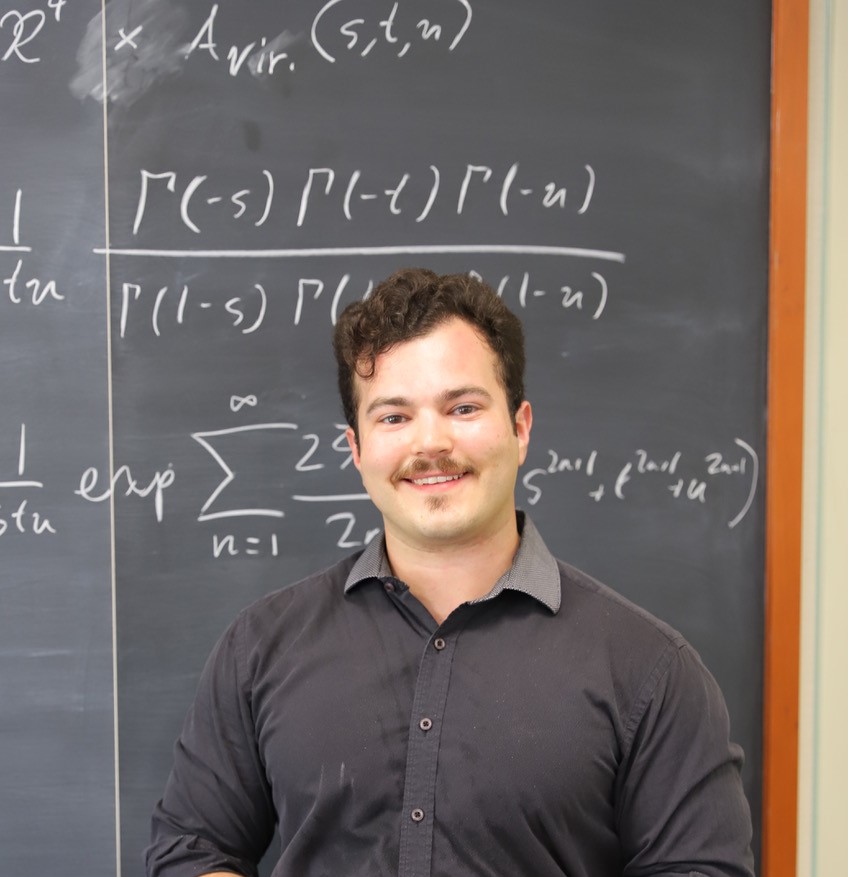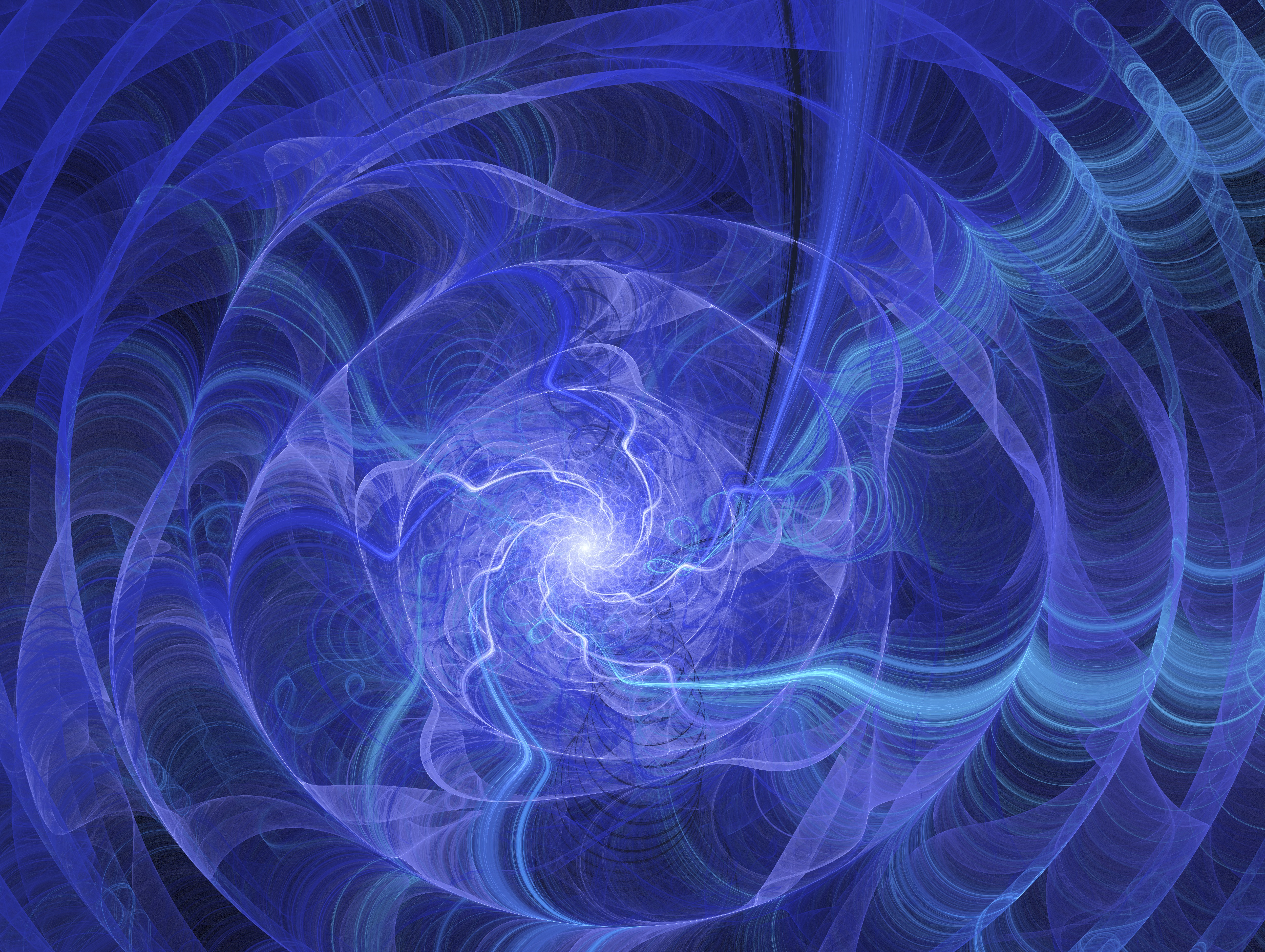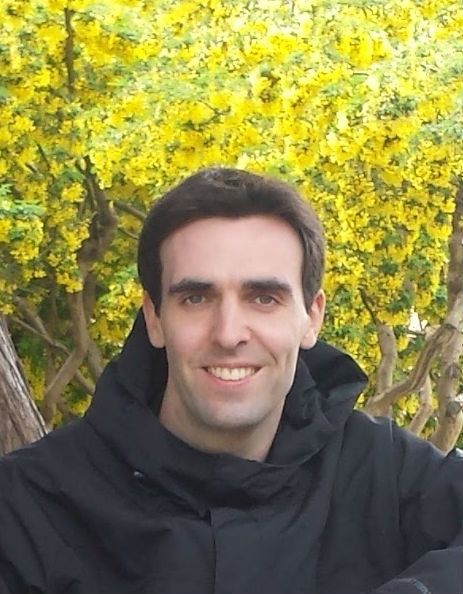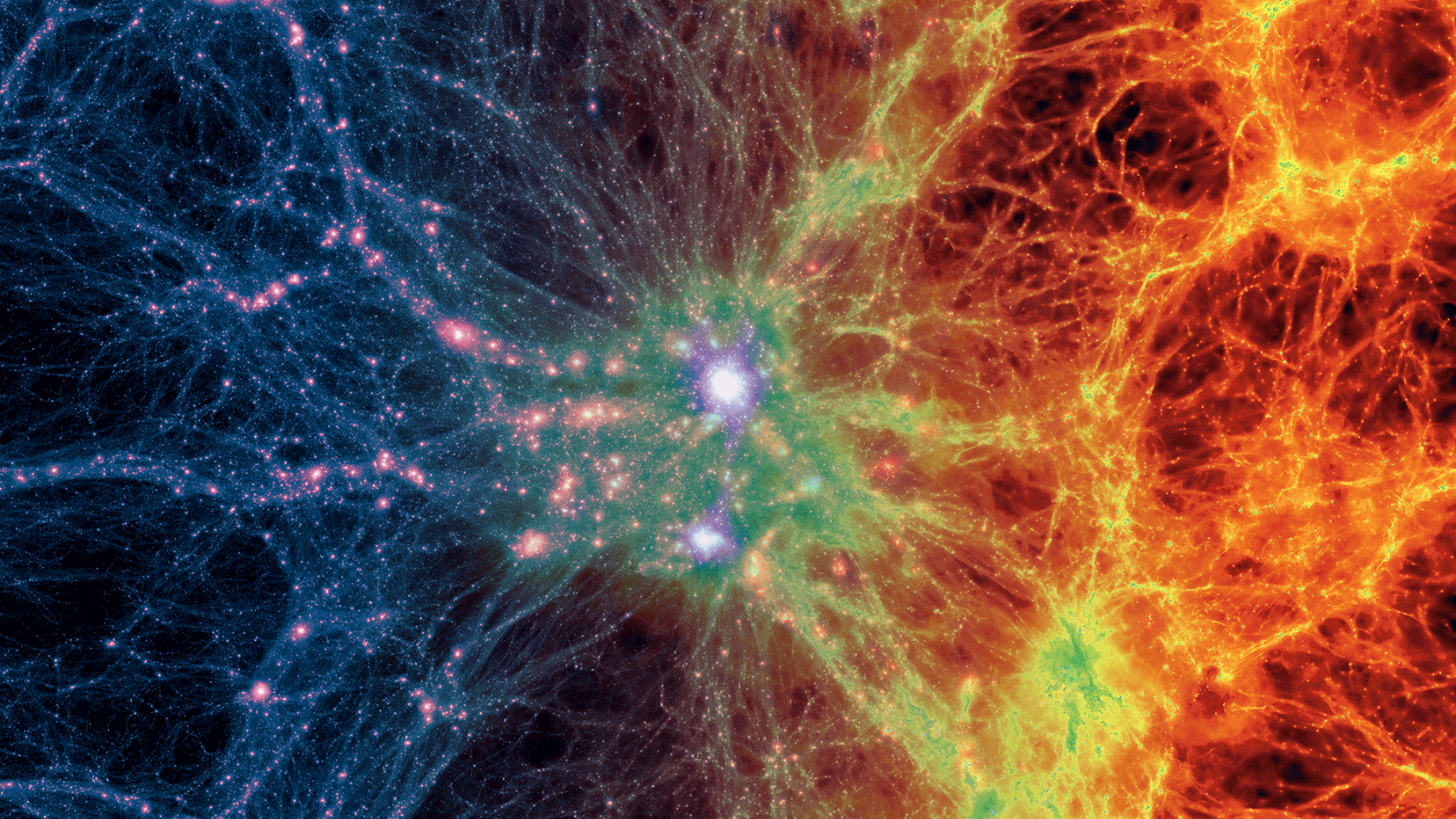What is string theory?
String theory might be the theory of everything… or a flawed framework for theoretical physics.

String theory is the idea in theoretical physics that reality is made up of infinitesimal vibrating strings, smaller than atoms, electrons or quarks. According to this theory, as the strings vibrate, twist and fold, they produce effects in many, tiny dimensions that humans interpret as everything from particle physics to large-scale phenomena like gravity.
String theory has been held up as a possible "theory of everything," a single framework that could unite general relativity and quantum mechanics, two theories that underlie almost all of modern physics. While quantum mechanics does very well in describing the behavior of very small things and general relativity works well to explain how very large things happen in the universe, they don't play nicely together. Some scientists think (or thought) that string theory could resolve the conundrums between the two, conquering one of the major remaining unsolved problems of physics.
But after string theory gained prominence in the late 1960s and '70s, its popularity among theoretical physicists fluctuated, according to a lecture by California Institute of Technology physicist John Schwarz, widely considered one of the founders of string theory. After countless papers, conferences and dry-erase markers, the breathtaking breakthrough many once hoped for seems further away than ever.
Nevertheless, the flurry of thought around the very idea of string theory has left a deep imprint on both physics and math. Like it or not (and some physicists certainly don't), string theory is here to stay.
String theory FAQs answered by an expert
We asked Nick Geiser, a theoretical physicist at UCLA, a few frequently asked questions about string theory.

Nick Geiser is a PhD candidate in theoretical physics at UCLA and will join the University of Michigan as a Leinweber and Van Loo Postdoctoral Fellow, working with Professor Henriette Elvang in the Leinweber Center for Theoretical Physics in June 2023. Geiser's research spans several areas of theoretical high-energy physics centered around scattering amplitudes. Scattering amplitudes are fundamental objects in theoretical physics that can be measured in experiments and reveal deep connections between physics and pure mathematics. Outside of research, Geiser works with a variety of organizations to support under-represented minority groups in STEM fields.
What is string theory?
String theory is a collection of ideas in theoretical physics in which the fundamental building-blocks of nature are not particles (such as the point-like electron) but instead strings. Imagine microscopic wiggling rubber bands.
String theory is primarily a theory of quantum gravity which elegantly combines the theories of gravity and quantum mechanics. Physicists have been searching for a theory of quantum gravity for nearly one hundred years. Moreover, ideas from string theory have been used to solve problems in mathematics and other fields of theoretical physics.
In many ways, string theory is a language that can be used by theoretical physicists to solve problems and to investigate the mathematics of the universe.
Who invented string theory?
String theory was discovered by accident! In 1969, Italian physicist Gabriele Veneziano wrote down a formula describing the scattering of four strings, the now-famous Veneziano amplitude. Veneziano was trying to describe the physics of particles like the proton and neutron, not strings. In the following years, physicists around the world began to unravel string theory from that first formula.
The full picture of string theory has become clearer over the following fifty years. There were several bursts of new ideas and deep insights in the 1970s, 1980s, and 1990s, and string theory is still an active field with thousands of researchers around the world.
Has string theory been proven?
No experiment has definitively proven string theory to be the fundamental theory of nature. However, the ideas of string theory have passed countless theoretical and mathematical tests over the last fifty years.
Fundamental physics is a long-game. Einstein first predicted gravitational waves in 1915, and they were first detected by the LIGO experiment in 2015, one hundred years later! Future particle physics experiments, gravitational wave observatories, or cosmological measurements may offer definitive tests of string theory.
How many dimensions are there in string theory?
String theory predicts ten total spacetime dimensions, but we clearly live in a world with four dimensions (three space and one time)! Thankfully, it is not a problem to get from ten to four. Six of the dimensions predicted by string theory could be wrapped into a small compact shape. These compactified dimensions could then only be seen by a large, precise experiment like CERN's Large Hadron Collider.
What is string theory?
String theory is a framework that physicists use to describe how forces usually conceptualized on a gigantic level, like gravity, could affect tiny objects like electrons and protons.
In Albert Einstein's theory of general relativity, gravity is a force that warps space-time around massive objects. It's one of the four forces that physicists use to describe nature. But unlike the other forces (electromagnetism, the strong force and the weak force), gravity is so weak that it can't be detected or observed on the scale of a particle. Instead, its effects are only noticeable and important on the scale of moons, planets, stars and galaxies.
Gravity seems not to exist as a particle of its own, either. Theorists can predict what a gravity particle should look like, but when they try to calculate what happens when two such "gravitons" smash together, they get an infinite amount of energy packed into a small space — a sure sign, according to astrophysicist Paul Sutter in a previous article for Space.com, that the math is missing something.
One possible solution, which theorists borrowed from nuclear physicists in the 1970s, is to get rid of the idea of problematic, point-like graviton particles. Strings, and only strings, can collide and rebound cleanly without implying physically impossible infinities.

"A one-dimensional object — that's the thing that really tames the infinities that come up in the calculations," string theory expert Marika Taylor, a theoretical physicist at the University of Southampton in England, told Space.com.
String theory turns the page on the standard description of the universe by replacing all matter and force particles with just one element: tiny vibrating strings that twist and turn in complicated ways that, from our perspective, look like particles. A string of a particular length striking a particular note might gain the properties of a photon, another string folded and vibrating with a different frequency could play the role of a quark, and so on.
In addition to taming gravity, string theory was attractive for its potential to explain so-called fundamental constants like the mass of an electron. The next step, theorists hoped, would be to find the right way to describe the folding and movement of strings, and everything else should have followed.
But that initial simplicity turned out to come at the cost of unexpected complexity — string math didn't work in our familiar four dimensions (three of space and one of time). It needed a total of 10 dimensions, with six visible only to the perspective of the little strings, much as a powerline looks like a 1D line to birds flying far overhead but becomes a 3D cylinder to an ant crawling on the wire.
How did string theory evolve?
String theory today doesn't exactly match the string theory of the 1960s and '70s. Researchers disagree over whether, with modifications, it's still the best candidate for a "theory of everything" or whether theorists should abandon it in favor of other topics.
"By 1973–'74 there were many good reasons to stop working on string theory," Schwarz wrote. Physicists' attention had turned from what felt like an unfruitful exploration of tiny undetectable "soft" strings and instead taken up more compelling evidence of hadrons, subatomic particles made up of quarks whose actions couldn't be explained by strings.
"What had been a booming enterprise involving several hundred theorists rapidly came to a grinding halt," Schwarz wrote. "Only a few diehards continued to pursue it."
Over the next decade, a few scientists continued to pursue five different versions of string theory. Over time, the researchers began to find unexpected connections between the five ideas, which Edward Witten, a theorist at the Institute for Advanced Study in Princeton, New Jersey, gathered up and presented at a 1995 string theory conference at the University of Southern California. Witten argued that the five string theories each represented an approximation of a more fundamental, 11-dimensional theory as it behaved in a particular situation, much as how Einstein's space- and time-bending theories of relativity match Newton's description of objects moving at normal speeds. That was the beginning of one string theory spin-off: M-theory.
The "M" is likely inspired by higher-dimensional objects called membranes, Taylor said, but since the theory has no concrete mathematical equations, the "M" remains a placeholder with no official meaning. "It was really a parametrization of our ignorance," she said.
Attempts to find those general equations that would work in every possible situation made little progress, but the alleged existence of the fundamental theory gave theorists the understanding and confidence needed to develop mathematical techniques for the five versions of string theory and apply them in the context where each theory worked.

Strings are far too small to detect with any conceivable technology, but one early theoretical success was physicists' ability to describe black hole entropy in a 1996 paper published in the journal Physics Letters.
Entropy refers to the number of ways that you can arrange the parts of a system, but without being able to see into the impenetrable depths of a black hole, no one knows what type of particles might lie inside or what arrangements they can take. And yet, in the early 1970s, Stephen Hawking and others used the laws of thermodynamics and, according to an article published in 2020 in the journal Physics, quantum mechanics to calculate entropy inside a black hole, suggesting that black holes must have some sort of internal structure. What that structure might be, remained a mystery.
Most attempts to describe the black hole's makeup fall short, but the configurations of hypothetical strings does the trick. "String theory has been able to give a spot-on counting," Taylor said — an actual possible explanation of black hole interiors, not just a rough idea.
The string theory framework still faces many challenges, however: It produces an impossible number of ways to fold up the extra six dimensions. Every option seems to fit the broad features of the Standard Model that governs particle physics, with little hope of distinguishing which is the right one. Moreover, wrote astrophysicist Ethan Siegel in his blog Starts With a Bang, all of those models for managing the extra dimensions rely on an equivalence between force particles and matter particles called supersymmetry. But, just like the extra dimensions that string theory requires, we don't observe supersymmetry in our world.
On top of those objections, it's not clear that string theory — M-theory or not — can ever be compatible with our modern understanding of an expanding universe, replete with dark energy, reported Quanta Magazine in 2018.
A number of physicists, such as Peter Woit of Columbia University, view these divergences from reality as fatal flaws. "The basic problem with string theory unification research is not that progress has been slow over the past 30 years," he wrote on his blog, "but that it has been negative, with everything learned showing more clearly why the idea doesn't work."
Taylor, however, maintains that today's models are overly simplistic, and that features like cosmological expansion and a lack of supersymmetry may someday be built into future versions. Taylor expects that, while the new era of gravitational-wave astronomy may bring new tidbits of information about quantum gravity, more progress will be made by continuing to follow the math deeper into string theory.
"I have a theoretical bias," she said, "but I think the kind of breakthrough I'm describing would come from a chalkboard; from thought."
Why is string theory still important?
Regardless of whether string theory can ever be massaged into a "theory of everything," its legacy as a productive research program may be assured on mathematical merit alone.
"It can't be a dead end in the sense of what we've learned just from mathematics itself," Taylor said. "If you told me tomorrow that the universe absolutely isn't supersymmetric and doesn't have 10 [spatial] dimensions, we've still connected whole branches of mathematics" using the string theory framework.
In particular, when Witten and other researchers showed that the five-string theories were shadows of a single-parent theory, they highlighted connections called dualities, which have proven to be a major contribution to mathematics and physics.
Dualities let mathematicians translate from one branch of math to another, attacking problems untenable in one framework by using calculations done in the other, for example in geometry and number theory. Other dualities have helped overcome challenges in quantum computing, according to Taylor. "It's not going to make your next-generation iPhone," she said, "But it may make your iPhone for the 22nd century."
Whether string theory's ability to illuminate the dark web connecting different areas of math turns out to be a sign of its potential or just a lucky coincidence remains a subject of debate. Witten, speaking at the Institute for Advanced Study in 2019, acknowledged that while he no longer feels as confident as he once did that string theory will evolve into a complete physical theory, his gut tells him that the theory remains a productive field of research.
"To me, it's implausible that humans stumbled by accident on[to] such an incredible structure that sheds so much light on established physical theories, and also on so many different branches of mathematics," he told the audience. "I have confidence that the general enterprise is on the right track, but I don't claim that the argument I've given is scientifically convincing."
Additional resources
Find more in-depth history and explanations of current string theory science at WhyStringTheory.com, a website created by graduate students at the University of Oxford and the University of Cambridge for the "interested layperson." Or, if you'd rather go right to the source, check out this CERN Courier interview with string theory originator Gabriele Veneziano. If you're looking for a video explainer, watch these two videos entitled "Why string theory is right" and "Why string theory is wrong," both from PBS Digital Studios.
Bibliography
- "Robbert Dijkgraaf and Edward Witten in Conversation - Videos | Institute for Advanced Study," May 30, 2019. https://www.ias.edu/video/universe/2019/0529-DijkgraafWitten.
- Schwarz, John H. "The Early History of String Theory and Supersymmetry," January 4, 2012. https://arxiv.org/abs/1201.0981v1.
- Siegel, Ethan. "Why Supersymmetry May Be The Greatest Failed Prediction In Particle Physics History." Forbes, February 12, 2019. https://www.forbes.com/sites/startswithabang/2019/02/12/why-supersymmetry-may-be-the-greatest-failed-prediction-in-particle-physics-history/.
- Strominger, A., and C. Vafa. "Microscopic Origin of the Bekenstein-Hawking Entropy." Physics Letters B 379, no. 1–4 (June 1996): 99–104. https://doi.org/10.1016/0370-2693(96)00345-0.
- Witten, Edward. "String Theory Dynamics In Various Dimensions." Nuclear Physics B 443, no. 1–2 (June 1995): 85–126. https://doi.org/10.1016/0550-3213(95)00158-O.
- Woit, Peter. "Frequently Asked Questions | Not Even Wrong." Not Even Wrong (blog). Accessed January 17, 2022. https://www.math.columbia.edu/~woit/wordpress/?page_id=4338.
- Wolchover, Natalie. "Dark Energy May Be Incompatible With String Theory." Quanta Magazine, August 9, 2018. https://www.quantamagazine.org/dark-energy-may-be-incompatible-with-string-theory-20180809/.
- Zayas, Leopoldo A. Pando. “A Microscopic Account of Black Hole Entropy.” Physics 13 (May 18, 2020): 80. https://doi.org/10.1103/PhysRevX.10.021037.
Join our Space Forums to keep talking space on the latest missions, night sky and more! And if you have a news tip, correction or comment, let us know at: community@space.com.
Breaking space news, the latest updates on rocket launches, skywatching events and more!

Charlie Wood is a freelance journalist covering physical sciences both on and off this pale blue dot. He contributes to Space.com and LiveScience, as well as Popular Science, Scientific American, Quanta Magazine, and others. These days he writes from New York but in previous lives he taught physics in Mozambique and science English in Japan. Find him on Twitter @walkingthedot.
